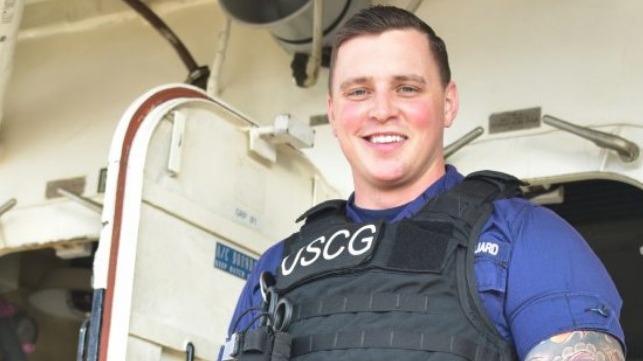Inside the U.S. Coast Guard's Anti-Drug Boarding Teams

[By Chief Petty Officer John Masson]
For Petty Officer 3rd Class Denim Kurtis, law enforcement is a family affair. His mother is a deputy sheriff and his father-in-law is an investigator for the San Francisco district attorney’s office.
So when Kurtis felt the call to serve his country, the Coast Guard’s maritime enforcement specialty was a natural fit. He initially joined as a reservist at a San Francisco-based port security unit before integrating into the active duty force almost three years ago. Today the San Jose, California, native serves aboard U.S. Coast Guard Cutter Bertholf (WMSL 750), operating in the Western Pacific.
“I honestly enjoy it quite a bit,” Kurtis says of his duties aboard the 418-foot national security cutter.
Whether those duties include drug interdiction in the Caribbean or Eastern Pacific Ocean or enforcing United Nations sanctions in the Western Pacific, Kurtis – one of two maritime enforcement specialists assigned to the ship – stays busy.
“The best part of my job is teaching maritime law enforcement to my shipmates, and making them as excited about our job as I am,” Kurtis says. “Also, being able to see different parts of the world, in areas I never thought to travel, has been eye-opening and a life-changing experience, in itself.”
Kurtis takes particular pride in keeping drugs out of the United States as part of the ship’s counter-narcotics missions.
“It’s an all-encompassing task when you’re out there,” Kurtis said. “We do it all, from gathering intelligence to the actual enforcement, then detention and offload” of seized illegal drugs. “It’s great to see it loaded off the boat and destroyed by the Drug Enforcement Administration.”
His supervisor, Petty Officer 1st Class Jon-Paul Smith, said Kurtis sets an excellent example for more junior service members.
“He’s a very outgoing individual,” Smith said. “He presents himself well, and he’s used to presenting on a level that is definitely higher than his paygrade.”
Smith said Kurtis has explained Bertholf’s law enforcement missions – and the Coast Guard’s – to large groups of foreign dignitaries and American congressional leaders. In addition, he takes a leading role in Bertholf’s law enforcement boardings, including one noteworthy search of a suspicious fishing vessel during which Kurtis located a large quantity of cocaine in a fish hold. The seizure became part of more than 3,000 kilograms of cocaine, worth more than $107 million, seized by Bertholf during a recent patrol in support of the Joint Inter-Agency Task Force off Central America.
Kurtis says each bale of cocaine the ship seizes when it is out to sea makes America a better, safer place.
“How many lives of families and police officers are improved by not having contact with those drugs?” he asks. “How many kids’ homes aren’t being destroyed?”
Those intangibles may be hard to measure, but the quantity of drugs seized by the Coast Guard’s national security cutters is not. In fiscal year 2017, the Coast Guard and its partner agencies intercepted 455,000 pounds of cocaine before it got to American shores. Of that amount, more than one-third was seized by national security cutters such as Bertholf. The total street value of the cocaine was more than $6 billion.
Kurtis, who is married with a two-year-old son and another child on the way, says it’s hard to leave family behind for the demanding deployments his job has required. Mission success makes the separation worthwhile, he says, but he also is looking forward to his next duty station, a shore-based unit in San Francisco.
“Some days I felt like the day would never come,” he says of the approaching end of his time on Bertholf. “And other days I really don’t want it to come.”
This article appears courtesy of Coast Guard Compass and may be found in its original form here.
The opinions expressed herein are the author's and not necessarily those of The Maritime Executive.
